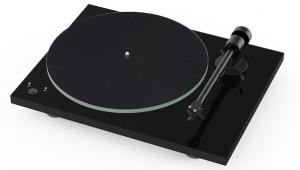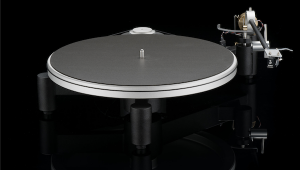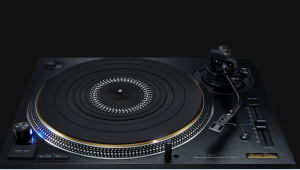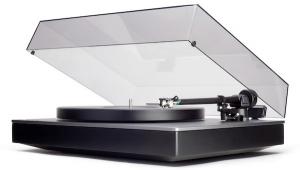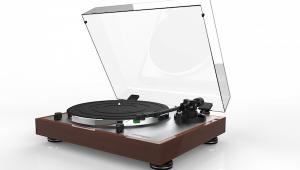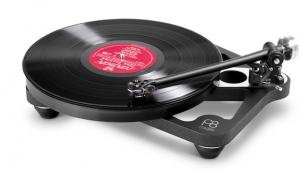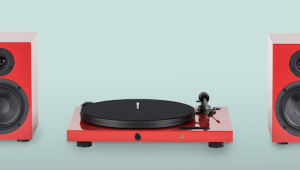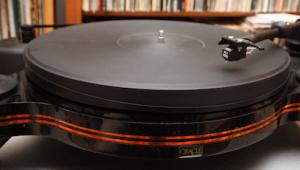"The solution here would be to add mass to the head shell"-you know,like taping a penny. ; )
Very desirable turntable! the 1200 is already quite "audiophile"-this table just up's the ante.
Despite the price difference,I would love a head to head between the new technics 'tables!
Exclusive: One Week With Technics' New SL-1000R Direct Drive Turntable (See update posted 2/21/18)
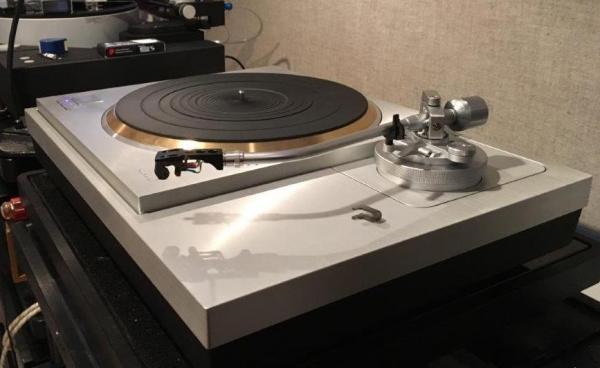
The SL-1000R is the fully integrated version of the SP-10R turntable, which is a "module" meant to be dropped into either an existing plinth for an older SP-10 or into a newly built one. Most of these are made of slate or graphite and the end user can use the arm of his or her choice either in an arm board integrated into the base or as part of a separate module.
The SL-1000R is the SP-10R built into a Technics plinth as pictured above that you can listen to in this video. You can also see an interview with Mr. Itan produced at last fall's Tokyo Audio Show.
The SL-1000R comes with a new 10" version of the special magnesium arm-tube arm that was part of the limited edition SL-1200GAE. According to Technics, the new arm has more precise bearings, analogous to what Rega does with its upscale arms that outwardly appear similar if not identical to lower cost ones but are not. The supplied arm is in a board that can be swapped out for a few other arms, with Technics supplying the boards, so far for an Ortofon and an SME. In addition there are two other arm boards that mount to the back and side of the plinth for a total of 3 possible simultaneous arms as seen at CES. You can see that on AnalogPlanet's CES video coverage elsewhere on this site.
The SL-1000R is a large and heavy assemblage weighing in at 88 pounds that sits on four specially designed damping and isolating feet (details best for full review). The SP-10R is a "drop-in" that features an approximately 18 pound full-sized brass platter, the underside of which is heavily damped with a black compound that fits within a machined recess on the platter's underside.
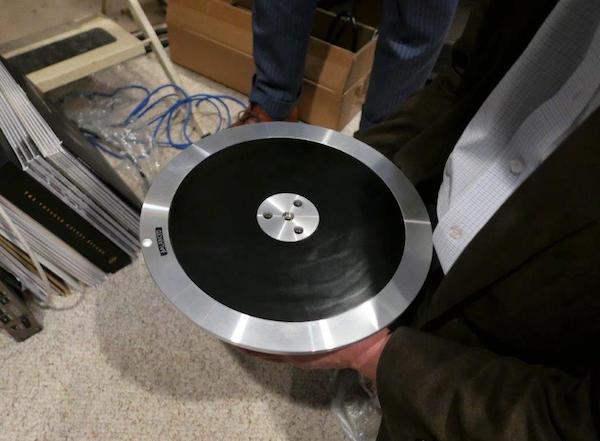
The power supply and motor drive unit is an outboard device connected by an umbilical to the main unit. It offers a large digital screen and complete speed and pitch adjustability the details of which are best discussed in a full review.
The supplied rubber mat is either identical or similar to the ribbed one that comes with less costly Technics turntables but I was told it's not likely to be what's supplied with the production model. I ended up using a variety of mats including the Funk Firm Achromat and Stein's Pi mat. I'm not a fan of thick soft ribbed rubber mats. A new Ortofon A95 was already mounted to the head shell so that's what I listened to. It's one of my favorite cartridges anyway and I'm well familiar with its sonic performance.
Because this was a pre-production unit I expected there might be a glitch or two and that proved to be the case. First I wanted to double check the cartridge set-up. The spec sheet said the 10" arm's effective length was 239mm, which is the standard Rega's effective length but that's a 9" arm so I knew something literally didn't add up.
The pivot to spindle distance of the Rega arm is 222mm with a 17mm "overhang" for that 239mm total. So first I used the WallyTractor's 239mm arc and not surprisingly found that the stylus did not come close to tracing the arc. Next I used the Acoustical Systems SmartTractor to precisely measure the pivot to spindle distance, which not surprisingly was far greater than 222. The measured number plus the 17mm overhang spec produced an effective length of 254mm, similar to that of Immedia's two arms.
All of this took place with the Technics people present, which for them was somewhat embarrassing but keep in mind that this was a pre-production model and probably someone at the factory simply copied the specs from the SL-1200 series arms and that led to this. I'm sure it would have been caught by someone before the SL-1000R went into production! Of course I re-set the overhang using the Wally Tractor's 254mm arc, though until it's confirmed I have no idea if the overhang really is 17mm!
Once the cartridge was correctly installed it was time to play tunes. Everyone from Technics enjoyed the sound the turntable produced in my system and you had better believe so did I! It was clear from the first record played that this turntable's speed accuracy and consistency was on a new level of excellence. I didn't need to measure it to hear it. When I did get around to measuring it, the results were even better than I was expecting. I've never seen such an impressive set of measurements. Here they are:

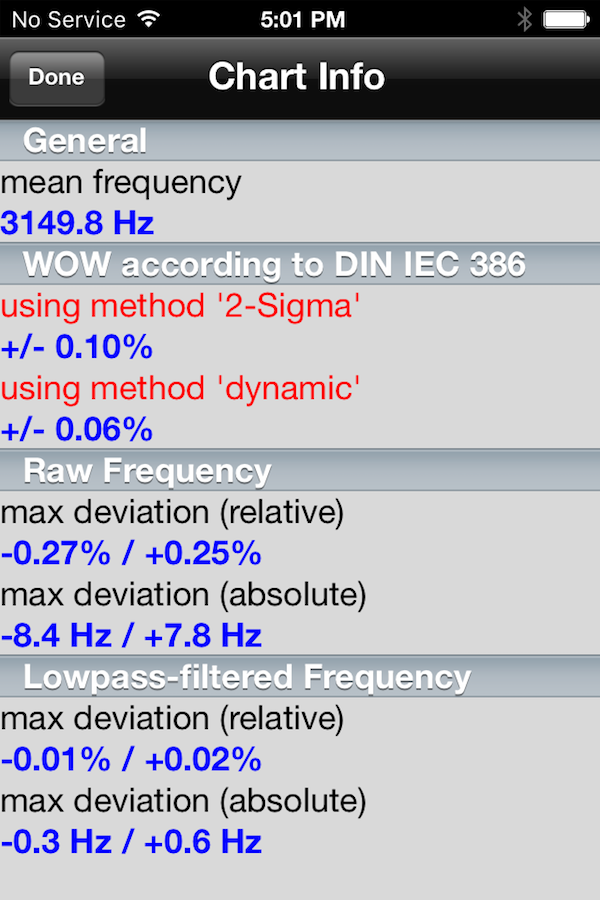
Those results prove that the SP-10R "engine" is either the most accurate or among a handful of the most accurate turntables ever designed and manufactured. It sounded as it measured, with a reel-to-reel tape-like rhythmic consistency and accuracy that produced severe relaxation and unprecedented, in my experience, low listener fatigue. You can get a taste of it in the video linked above. The sound was notably smooth yet precise. Transients and especially vocal sibilants were well-articulated and "clean" with not a whiff of "etch" or hardness. "Grain" was nonexistent. What was easily audible at CES was repeated (not surprisingly) at home. Record after record produced big "wows" from me.
My only issue was the bottom end, which was not as well articulated and seemed to vary from record to record. It wasn't as deep and firm as I'd expected given what the rest of the audio band sounded like. When I used the Hi-Fi News test record and measured the arm/cartridge resonant frequencies lateral and vertical, I found out why: in both planes the resonant frequency turned out to be centered at close to 16Hz, which is too high. It should be between 8-12Hz or above "warp/wow" and below the lowest possible musical information engraved in the record.
The reasons for this were obvious: the A95 is an unusually light cartridge weighing in at approximately 6 grams. The arm was originally designed "in the day" for high compliance moving magnet cartridges. However, most moving coil cartridges weigh in at around 11 grams, some higher, which is why the Lyra Etna performed so well on the 1200 reviewed here last year.
The solution here would be to add mass to the head shell. 11 total grams at the head shell would produce a resonant frequency in the ideal 8-12Hz range. I didn't add mass to the head shell for this encounter but I think Technics will either have to include a heavier head shell option or list recommended cartridge weights and compliance figures.
When I went back to my reference turntable featuring an arm that costs more than the entire SL-1000R assemblage the results were a mixed bag. The Technics SL-1000R produced that "tape like" sensation the big rig didn't quite have, which of course was disappointing! But the bottom end was significantly better. Some of that was due to the resonance issue but I don't expect the SL-1000R's arm to perform as well as the Swedish Analog Technology arm. I think the supplied arm is very, very good overall and given the SL-1000R's cost of approximately $20,000, it's almost (dare I say) a "freebie" considering the performance of the 'table itself.
I also felt that the Continuum/SAT combo had "blacker blacks" and a perceived lower noise floor for reasons understandable to anyone who knows the design of the Continuum chassis (cast magnesium based upon vibrational analysis) and especially its unique "floating" three dimensional arm board. But we're talking about almost $200,000 versus $20,000 and in the key factor of speed consistency, the Technics was the clear winner and it was audible though of course the big limitation is record eccentricity or lack thereof.
To really know how good a performer is the SP-10R portion of the SL-1000R requires hearing it dropped into a slate or graphite or whatever is used by the "outboard" designers, combined with an SAT or other "stupidly expensive" state of the art tone arms. However, as delivered for around $20,000 the SL-1000R presents a formidable challenge to just about anything available from other manufacturers at just about any price—especially in terms of speed accuracy. One listen and you'd be hard-pressed to disagree.
The SL-1000R plinth as currently designed does have some issues. It's not "user friendly" if the user wishes to use arms other than what's supplied or the two for which Technics plans to offer arm boards. In addition as currently configured you will need a straight DIN to RCA or DIN to XLR cable (Technics supplies one and if you don't think cables make any difference you're all set!) because angled ones cannot fit into the very constricted space at the back of the plinth.
Another issue is the low platter height relative to the arm, which only becomes an issue if Technics decides to supply a "universal" arm board that you can custom drill. Even with the supplied arm, achieving 92 degree SRA with the A95 required the arm to be raised almost as high as the built in adjustment allows.
Of course in an ideal world, Technics would completely re-design the SL-1000R's arm interface to make it easier to use a wider variety of arms and lower the mount to make height less of an issue. I doubt that's going to happen, which is not that big a problem. For many who can afford to spend $20,000 or so dollars, the supplied arm and SL-1000R infrastructure will produce spectacular "out of the box" sound and for those who insist on coaxing every last bit of performance from the spinning system, there's always the $10,000 (appx.) SP-10R plus a custom plinth designed for your choice of arm.
My hope is to review both the finalized SL-1000R and an SP-10R set into a custom plinth designed to handle the SAT arm (and perhaps have it sitting on a Minus-K stand). Only then will it be possible to know the true full potential of what is clearly a brilliant design and execution of the latest "state of the art" turntable from Technics. That said, the SL-1000R made for an exciting and musically satisfying (and addicting) listening experience. Unfortunately Technics' ability to manufacture these is limited because of the time consuming motor building process so if you want one and you can afford it (in either form), get your order in as soon as that's possible!
Assembling SL-1000R at CES in Las Vegas
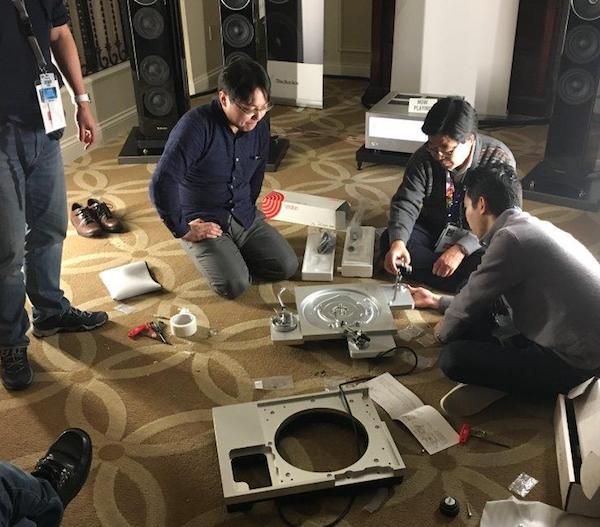
- Log in or register to post comments


This is the best turntable ever made at any price. A lot of companies should be embarrassed right about now.

Will you be selling the Caliburn for one of these?

Great insights. Concerning the technological innovations introduced by Technics I rather would expect they get a licence to build the Technics version of the parallel tracking tone arm from ELP Corp. used in the laser turntable. That would be a nice joint venture of cutting edge technologies! Regards

At this level of detail and price, I don't get the point of having a tonearm attached to a plinth. Why not have an outboard tonearm/armboard? I realize the setup will take more time, but it seems like an arm on a plinth is an unnecessary limitation.

I've seen a platterspeed test of a Rega RP10 and here are the results. (someone shared these results with me I don't own the RP10)
3148.5 (this is adjustable so if you really wanted to geek out you could get it closer to 3150)
+/-0.09%
+/-0.06%
-0.20%/+0.22%
-6.3 HZ/+6.9 HZ
-0.02% / +0.03%
-0.5% / +1.0%
I also have a Rega P3-24 with the NEO PSU below are the PS results.
3150.7 HZ
+/-0.11%
+/-0.06%
-0.24%/+0.22%
-7.6 HZ/+6.9 HZ
-0.02% / +0.02%
-0.5% / +0.5%
I'm finding Rega's are testing very well, especially with the NEO PSU.

Great results Atomlow!
Here are the numbers from my second hand Technics SL-1200M3D about 15+ years old (made in 2002):
Mean freq: 3149.8
WOW - 2-Sigma: +/-0.11%
WOW - dynamic: +/-0.08%
Raw freq:
Max relative: -0.30% / +0.28%
Max absolute: -9.5Hz / +8.8Hz
Lowpass-filtered:
Max relative: -0.02% / +0.02%
Max absolute: -0.8Hz / +0.5Hz
Graphs can be found here:
http://archimago.blogspot.com/2014/08/measurements-technics-sl-1200-m3d-...
I wonder what the variability is for the Adjust+ test LP since I'm sure each one will vary just a bit and details like decentering of the spindle hole will play a role especially for the absolute frequency shifts.

Those are good numbers and I enjoyed reading bog page about your results. I've found the Feickert 7" tests better than most testing lp's. Mine is cut with a perfect spindle hole. I do clamp it down because the record isn't tightly fit on the turntable.
Here are another set of results just to show how my Rega p3-24 usually tests, I gave the best reading I've ever had with the p3 above ;)
Mean freq: 3152.0 Hz (always adjustable)
WOW - 2-Sigma: +/-0.14%
WOW - dynamic: +/-0.11%
Raw freq:
Max relative: -0.39% / +0.31%
Max absolute: -12.3Hz / +9.7Hz
Lowpass-filtered:
Max relative: -0.02% / +0.02%
Max absolute: -0.7Hz / +0.7Hz
Cheers!

I hope I didn't come off as hyper ;) but I am a Rega fanboy. How can you not be? I will go find a Stereophile tonight to see how the RP10 tested. Like I mentioned above I have a platterSpeed screen capture of the RP10 and it tested better than the Technics. It's all cutting hairs really when the numbers are good. Look at the numbers on the audio-technica lp120 that you reviewed. It had impressive platterspeed numbers, but it doesn't give the full picture on sound of course.
Michael you should inform the other Stereophile reviewers to update their platterSpeed apps to include the wow and flutter results. I think I'm talking about Herb. :)

After seeing your review of the RP10 and seeing the PlatterSpeed results it becomes apparent Rega has an edge. At this point, you buy for philosophy reasons. Also, you buy realizing you can save thousands of dollars for the best. Simmer down.

Thanks for this very nice early review! Looking forward to the May launch in the USA and your next review.

... if that's the same headshell as used on the SL-1200GAE, then it weighs about 7.6g. The brochure for the SL-1000R illustrates it equipped with an Ortofon LH-6000 headshell, which weighs 13.5g, and what appears to a Cadenza Black or PW or PW Ti cartridge, the weight of which would range from 10.7g to 13g.

to think that folks can engineer something that is so fantastic yet they can't get it together to match the right cart to their tonearm for proper resonant frequency? Seems like they sure are leaving a lot "back at the shop" by not getting this basic detail sorted out. I sure as hell ain't smart enough to design something as great as this TT, but I can figure out this basic concept. Does make you wonder...

I'll be sure to pick one up the next time I have $20,000 lying around.
True, it's a "bargain" compared to all the really high-end tables and arms, but...
Are all of you folks independently wealthy?

@Tom L, the $20k is for the complete Turntable system. Many enthusiasts have Technics legacy SP-10 or SL-1000 so the SP10R upgrade with control box is only $10k.

Are your favorable impressions due to the Technics speed accuracy being the same or close to the accuracy of record cutting machines? What kind of system do they use?

Are you permitted to share FLACs dubbed from this ‘table?

I’m very intrigued by this new table too. I’ve been using two SP10 mkllls in custom plinths with redone power supplies for about 10 Year’s now. I’m glad to see Technics making this type of table again. They’re wonderful, and make no mistake where the DNA for this one comes from. I have a feeling you’re about to “rediscover” what many of us have been experiencing for years.
Just in the nick of time too. Donor units for custom plinth makers are running thin these days.

The SL-1000R will likely be very good or even great. The SP10-R will be where the rubber meets the road. If it’s close to as good as the SP10 mklll you can drop it in a custom plinth with 1-4 premium arms of your choice and essentially have four reference tables in one spot. I’d like to hear this table in an Artisan Fidelity NG-S plinth. I’ll lay you money that combination will happen soon.

Michael,
Is this turntable up there with the VPI Classic Direct?
Assuming I put on a SME V tonearm or a Swedish Audio Technologies arm?
I would be setting it up with two tonearms, one stereo, the other with a mono cartridge.
I would most likely be running Lyra Etna or Atlas cartridges - one mono, the other stereo.
Your opinion?
I was looking at the VPI Classic Direct, that that table does not have speed control. This one apparently, does. For albums like Beggars Banquet and Blood on the Tracks.

Luckily 5 years later their new $20,000 table almost equals the speed accuracy of the VPI Direct Drive. You can buy a VPI Direct Drive motor for $10,000 with the controller and the whole thing made in the USA. According to Michael's own testing, the VPI Direct Direct motor has lower Wow and flutter. Don't go by the wave form picture because the timeline between the Technics and VPI Direct Drive the range was extended for the Technics (which makes it looks smoother). It was half the measured timeline for the VPI Direct Drive.
We would be more impressed if Technics didn't already pull out once from this industry when it slowed down. And they will do it again on the next slow down. Regardless of them eventually leaving again when the going gets tough, let's do a shoot out! Can to can :)

Cool, and great to hear from the source.
I was going to modify a VPI Classic Direct, a Peter Noerbaek custom job, with two tonearms.
The issue I have with the VPI is the lack of pitch control. Too many old LPs have speed issues.
Are there plans to include a pitch control for the VPI Classic Direct?
Thing is, that pitch control is something the Technics has going for it.
And it's something I do use on my own turntable, an SME 20

That is something for us to think about, no reasons why we couldn't add a pitch control :)


You make a pretty certain sale of a Classic Direct at some point in the not so distant future :-)
Three reasons:
1. Beggars Banquet
2. Blood on the Tracks
3. Kind of Blue
Plus others.
Thing is, the SME has a pitch control, it relatively easy to go up and down once you get used to clicking the motor control.

And I love how you defend your product, which we all know is incredible. But I hope there is no “next slow down.”

Still around/available we just don't push it since it is a Harry dedicated item which makes the lead time range between 1 week to when he feels like it :p
We are working on making the design less Harry dependent.

Being the owner of a Sp 10 Mk II, having heard the new Classic Direct at the Capital Audio Fest, and having drooled over the SP 10 R, (and not being able to afford either sniff sniff) Id love to hear that shoot out. If Technics will just loan me one to drop into my plinth, and Mike Bettinger will bring me a Classic Direct next time he comes south to Richmond, Id be happy to do just that. Im not holding my breath.

SME V or a SAT tonearm. The magnesium arm on the SL-1000R is absolutely state of the art. Materials, craftsmanship, adjustability, is as good as the best and better than most high end tonearms. In the early 80's, Technics had the best tonearms in the world without equals. Ruby bearings and titanium boron alloyed tonearm wands. Just let that sink in... Titanium boron alloy is incredibly expensive and practically is an unobtanium to most. No one has ever attempted anything like that since. Technics tonearms are incredibly and unfairly underrated.

...for the magnesium tonearm on the SL-1200GAE with that of the aluminum tonearm on the SL-1200GR. What do difference do you see?

that magnesium practically doesn't ring at all, whereas aluminum undamped rings like a bell. Have you ever struck a magnesium tuning fork? Ringing decays immediately. Tapping a magnesium tonearm feels and sounds like tapping plastic. Magnesium is also lighter than aluminum. It's a very good metal for a tonearm.

... Hi-Fi News test reports for the tonearms on the SL-1200GAE and the SL-1200GR.

I love it. It is the one I have. With a Lyra Skala.

... $10K-20K Technics unit really any better than that of this $500 Onkyo turntable?
https://www.analogplanet.com/content/onkyos-cp-1050-direct-drive-turntab...

... which shows that the speed of the Onkyo is more accurate than on this Technics. Max deviation numbers are essentially identical.

Mikey,
Thanks for the scoop....
I whipped out my 7" Feickert Test Record after seeing your results....and clicked on the Platter Speed App on my iPad only to find that Feickert won't support the 7" disc for accuracy but even more alarming.........they will not update their Platter Speed App for IOS11 or higher operating systems.
How do you manage to keep posting your charts?
Regards
Henry

I'm sure Michael is using an old iphone dedicated for testing. I'm using an old iPhone 3gs and will keep it only for the purpose of using PlatterSpeed. PlatterSpeed is such a great testing tool.
By the way, I like VPI just fine but the results between the VPI and the Technics are very similar. When Michael tested the VPI Direct Drive his app didn't even have the wow and flutter upgrade installed. The VPI raw frequency results did rate better but overall by a couple ticks but nothing substantial.
Why not save $24,000 and just buy a Rega RP10? Save $26,000 and buy an RP8. Save $28,000 and buy an p6? If I was VPI I wouldn't worry about Technics I'd worry about Rega and Roy Gandy. Roy Gandy was in it through thick and thin and innovating more than any designer in the world during the downfall of vinyl. Though VPI doesn't need to worry about anyone since they make great turntables made in the U.S.A. Though the Shinola connection is interesting.

Why would someone produce a $25K+ Gadget and make it look like every plasticky 70s turntable there ever was? Memories of disco nights? Urban pioneers — now retired with some money — attempting to remember dancing the night away at the Black Banana or Palladium?

It is expensively made but LOOKS like — or reminds one of — a plastic or silver-painted wood 1970s turntable. Certainly much of that is personal taste but even in the 70s the more high end turntables had lacquered wood plinths, like the Luxmans. Each to his own taste of course but it reminds me a bit of the rebuilt house at the end of the Steve Martin movie, “The Jerk.”

Thanks Mikey for a much needed preliminary assessment of this gorgeous table.
And thanks Mat Weisfeld for your defensive and critical comments about your competition. You have just guaranteed that I will never buy a VPI product due to your unethical comments.

Nothing defensive or unethical. I'm sorry to hear you won't join the VPI family but we will still be making and supporting our customers regardless of the ups and downs of the industry.

Matt, a wise man will Ccept criticism and acknowledge a mistake. Commenting on how great your own products are in the comments section of an article about your competitors products is highly unethical and the sooner you admit that or realise that the quicker you can get back to selling turntables. Can you really picture any of the high end firms doing what you did? No I didn't think so.

Unethical behavior is an action that falls outside of what is considered morally right or proper for a person, a profession or an industry. Using the comments section to promote your own products whilst trashing a competitors product within the review of your.competitors product says a lot more about the poster than his products ever will. I personally see nothing wrong with encouraging those in the high end industry to behave gentlemanly.

We have to remember that this turntable is " only " to celebrate the 100th anniversary and not the best Technics work/design.
https://forum.audiogon.com/discussions/upcoming-technics-sp-10r-100th-an...
If Technics decides in a near future to goes seriously in the analog high end market its first move must be to stays surrounded by true expert music lovers and audiophiles with the knowledge levels on what our market needs.
If they decides to make that then no one of today top analog high end manufacturers can compete with Technics and eventually with Denon, Sony, Pionner or Yamaha. No, VPI can't do it.
I´m talking of other level of everykind of resources ( talent, money, research skills, etc, etc. ) to do it, endless " power " to do it and a challenge no other today high end manufacturers can achieve it.
Unfortunatelly I don't really think they could be interested with a so small kind of market that sooner or latter will dies in the digital alternative " hands ".
We will see.
Cheers.

Looks like Rega and VPI are already sweating. I don't see Technics leaving snarky comments when their competitors tables get reviewed!
The VPI direct drive table is $30,000, the Technics is $20,000. I am sure the VPI is good but I like the looks of Technics better.
A great time for turntables either way!


Sweating? Did you see Mat’s picture in the post above? He looks like John Kreese of the Cobra Kai. He sweats nothing! Sweep the leg.
He’s got a good point. Vinyl sales may tank again but they’ll still be churning out tables.

they're sweating. These smaller companies have enjoyed a decade or more of charging ridiculous prices for very little technology and very simple turntables. Now they have actual competition. Technics SL-1200G is destroying the market for under $10K.

Very simple turntables?
In theory a turntable is a simple idea, but manufacturing turntables to get a good price to performance ratio is not so simple.
Rega for one cottage manufacturer of turntables have not just been making little technology and very simple turntables. There is a lot of engineering prowess in any one of their turntables and given the price points they want each to hit while making a fair and healthy profit.
Oh it may look like the just plaster together a plinth, platter motor and tonearm, but they don't.
Rega makes quite exquisite tonerams for one. These consume as fair amount of the price for each turntable made. The tonearm will ultimately make or break the sound quality of a turntable. The R&D, manufacturing and assembly of each tonearm cost a fair sum, notably as Rega moves arm models up higher and higher requiring a doubling down on quality assurance.
Plinths all look simple but given price point each Rega plinth stands to the core of Roy's ideology going back 40+ years. Not only must each plinth design match the light weight but rigid design, each must be manufactured and holes made for parts fitment to high tolerances. Their higher up models feature plinths of even more unique design and materials, all costing good sums of R&D cash and of manufacturing costs.
The platters are not just after thoughts, the float glass platters for one must each be carefully made to not only keep truness but look good enough for buyers to enjoy.
Sub platters, even the oh no plastic ones must be made to run true to speed (with acceptable tolerances), be stiff and rigid, but also lightweight. Nothing wrong with their plastic based subplatters, these can and do work as well as any other. They move to aluminum platters higher up mostly for added bling and prestige, less verifiable performance increases, but that is ok as buyers require more bling and prestige once they spend more cash.
Platter bearings are in general all similar in turntable design as to price v. performance. Rega for one given price point inputs a high quality platter bearing as any other turntable manufacturer.
Motors are all tried and true design. Given price point to performance all manufacturers employ competent and tried and true motor designs. Even Technics use a motor design in direct drive that is DECADES old. They just have refined it to price point and over built it by design. But it's not some new Area 51, alien technology.
All in all what has kept Rega relevant for decades was a STAY TRUE to ideology of principle. Refine and refine it some more all over the years to each price point that Rega wants to stay relevant in. From say $500.00 US to $5000.00 US Each turntable made reflects 40+ years of ideology and each model excel in the price point they sell at.
Technics today do not sell entry level turntables. They have offerings from a modest price to very expensive given to the minds of most consumers. They may earn their market share and they look to sell competitive models to price point but they have not reinvented the wheel so to speak.


The only reason I brought up Rega is that Michael mentioned the Technics PlatterSpeed test being the best he's tested. I had access to PlatterSpeed results that were actually better from a Rega RP10 and of course, the Rega is a belt driven turntable. I find it impressive they are testing as well as direct drive turntables costing $20,000. I'm sure Roy is losing sleep at night of Technics. I think Technics is a great turntable company so I'm not trying to bad mouth them one bit. I find simplicity in design to be a virtue. You are sadly mistaken if you think Rega isn't a leader in turntable engineering.

... Hi-Fi News test results, you'll see that both the Technics SL-1200GAE ($4000) and the SL-1200GR ($1700) have speed accuracy and speed stability that measured better than for the RP10 ($5500).

The specs are nice but 99.9% of all humans would not be able to audibly discern the minor speed variances between the three turntables as noted here or most any other competent turntables. Unless the turntable was made with a flaw, the issue of speed is a non-issue and has been for decades on quality LP playback.
Other issues may have greater impact to final sound, quality of tonearm design and manufacturing, ability to control or deal with resonances and other vibrations, longevity of parts used and general synergy between a cartridge, tonearm and plinth.

IMHO filtered speed accuracy/stability of turntable drive systems has advanced to the point that we have past the point of deminishing returns. However, what I have worried about for so long is the silent elephant in the room, namely the speed variation that is produced by an off center record. I know conventional wisdom explains this speed variation as being below the audible range, so it is filtered, and or ignored. Have you ever wondered what this eccentricity does to the poor stylus and cantilever? It can't be a positive effect since the stylus is actually being forced to displaced side to side with each rotation, which is in opposition to the purely spiral path of the ideal groove path. These lateral motions create a low frequency signal that dwarfs the mean filtered speed variation values.
I have built a turntable that has an adjustable spindle position provision. I have compared eccentric records both before centering, and after centering. I have observed that there is not only an improvement in speed stably, but I am afraid to report there is also a beneficial audible difference after centering as well, which after all is the most important thing. I am not advocating that everyone should dive off the deep end and center records as I have done. But instead, I just want to share my findings, that IMHO the current state of the art in well designed motor drive systems is no longer the tall tent pole.
Al

... to the off-center record pressing problem 35+ years ago with the TX-1000. That was a $7K turntable back in 1982, or about $18K today.
Technics ought to try to revive that design because that could be a turntable for which it might actually be worth paying $20K.
Unfortunately, it would probably end up being priced closer to $50K.

This is where bearing friction comes in. I find an off centered record simply a disaster, also because this is a case of pure neglect at the press. The first record from a run that comes off the press should be painstakingly examined, there and nowhere else. If not, a whole run will be faulty. The quality check (if any!) at the packing department, so when the record is put into its inner sleeve, can’t possibly notice an off centered record. Anyway, since there is always a slight tolerance for the diameter of the center spindle and center hole of a record, the tone arm bearing friction should be as low as possible. If not, excessive forces will be applied to the walls of the groove each time the tone arm is forced to be moved back and forth. This will strain the vinyl, the cantilever, the suspention and the stylus. This is one of the reasons records wear fast is bearings are damaged or if cheap Crosley’s are used.

My record centering process utilizes an adjustable record spindle positioner. The record spindle is independent of the platter bearing, it rides in a dovetail that allows it to be displaced 0.10" from the platter bearing axis and then clamped down. The most difficult part of the process is determining the maximum runout of the record grooves, and the angular position of the maximum. This is accomplished visually using a magnifier and a 6" machinists scale that has 0.010" graduations. I have also used a USB microscope that was purchased for setting VTA. When the max runout is determined a notation is made on the record label to record max runout and position. This must be done on each side of the record. The max runout location is then aligned to the offset spindle. I final check is then made to verify correct cancellation of runout. If you would like more detailed information, please provide your contact information.
Al

M.Fremer: """ Once the cartridge was correctly installed...."""
I can't really be sure that tonearm/cartridge alignment set up was " correctly " as you said.
There are some interesting points to consider: the longer Technics effective length was 250 mm in the EPA 100 design where in the 1200 was 230 mm. Makes " no sense " that suddenly Technics decided to have 254 mm as you said.
Now, the Löfgren alignment solutions, A and B, tell us that using the IEC standard with an effective length ( one of the 3 input parameters in his equations. ) of 254 the overhang ( with either solution. ) is not 17 mm.
In the other side you measured the pivot to spindle distance as 237 mm and this is the only true parameter you have on hand and for this parameter the effective length with Löfgren solutions never is 254 mm as you pointed out.
Was unfortunated that you did not test it the TT/tonearm/cartridge in exactly way as you received tomattest its performance before you change in a non-orthodox way the critical alignment of tonearm/cartridge.
You said that did not like you the bass range quality performance and that was because a out of " ideal " range " of the tonearm/cartridge resonance frequency that measured at around 16 hz where you posted that you need to add 11 grs to stay in the " ideal " range and here something is wrong with you because first the higher Technics effectife mass was 15 grs. in its tonearm designs.
Now, the A95 weigths 6 grs. with a 13 cu on compliance and taking in count these value parameters and your 16 hz figure you mentioned you need a tonearm with 3 grs. of effective mass for the A95 could resonanate at 16 hz ! ! ? ? ? !
Your alignmente and all those measurements you took were not clear for say the least or a totally misunderstood of the whole problem and this is why you find out those bass " problems " but not because the Tecvhnics or the combination with the A95 but because your non-orthodox alignment where every fraction of mm. is critical and change the distortion levels and overall quality performance.
You still have the Technics unit why don't comeback to the original Technics status/alignment and test it to see how it performs.
There is something that makes sense to me in the technics original alignment and I'm not saying it's the way technics did it but:
as I said the long effective length in a Technics tonearm was choosed by them as 250 mm. In the other side normally/many japanese tonearms comes with the Stevenson alignment in their specs and if we take 237 mm P2S distance ( that you measured. ) it is extremely centered at an effective length of 250 mm using Stevenson alignment. This is only something to take in count and I'm not saying I camn't be wrong.
Anyway, the point is that Technics put its nail in this market.
In the other side and not only because you pointed out but because other gentlemans posted about VPI and Rega speed stability designs that are a challenge for the Technics and other TTs:
speed stability is a critical TT target design and as important as it's does not defines per sé the overall quality performance for any TT. All we know that other TT design characteristics that are way important too.
Now, that I'm talking about you have to think that bass performance quality in a TT/tonearm/cartridge depends not only on its accurate set up but how well damped is the plattform where the TT is seated and the tonearm internal wire quality level.
A in deep review is mandatory of this Technics combination and compare it with the other units you have on hand with " everything the same ".
Greetings.

He knows this stuff better than most. Lots of good points and information.

*based on Lofgren alignment* that's not Stevenson alignment, which is what the turntable calls for.....

Mr. Fremer: There are many inconsistent information in your thread and seems to me that the problem could be a in deep misunderstood from your part in the overall alignment subject. I said this because years ago in this site that kind of inconsistent knoledge where there and you can read about here:
https://www.analogplanet.com/content/uni-din-versus-l%C3%B6fgren-b-just-...
As I posted that P2S 237 mm could belongs to Stevenson JIS standard alignment choice.
Btw, you posted:
""" The arm was originally designed "in the day" for high compliance moving magnet cartridges.... """
I don't know from where you took this information because it's not true and let me explain amlittle about:
Technics choosed a gimball/non-unipivot tonearm designs for very good reasons and between them that they manufactured from 1977 not only MM cartridges but LOMC too and they started to manufacture turntables with integrated pivot tonearm in the begin of 1980 to support both markets and its own cartridge designs. I think that only Grace started to design its tonearms for MM and latter on for LOMC too. Almost all japanese tonearm designs were as Technics in that regards: Micro Seiki, Denon, FR, Dynavector, Audio Technica, SAEC or Stax. The market competition on those times was with a unique " fierce " in between all them and many others manufacturers of cartridge and tonearms. That's why those vintaje products performs with that so high quality levels that even today can , some of them, the best of today top audio items.
Now Technics top tonearm designs all comes with a removable headshell characteristics ( as a fact all its pivoted ones are similar in this regards. ) and a unique and special very well enginnered damping/resonant mechanism that permits ( example: EPA 100 or 250. ) to mount any cartridge no matters not only its weigth but more important: its compliance value.
Today exist no single tonearm that can do that.
I own and owned the best of Technics tonearms and cartridges and from other " venerable " japanese great items manufacturers where some of them are second to none.
For the gentleman that posted about Rega I have to say that I admire Roy even his LP recordings are great but when I talked about Matushita ( where Technics belongs. ) I'm talking not only an endless everykind of resources but that does not exist over the audio world whom can compete with.
Btw, the SL-1000R motor is not of the same as other gentleman posted here. This one is a creless design and diferent from the SP10MK3 in the other side and only for each one of us audio " records " some of the best motors that comes with the cutting lathe machines are DD by TECHNICS as are the ones in the Micro RX 5000/8000.
Mr. Fremer I hope all this can help in some ways. Can I be wrong?, of course could be.
Kind regrads.

I forgot. The removable headshell permits to change the effective mass of the tonearm due that exist headshells with a wide weigth range coming from: 3-4 grs. to over 18grs.
Even Technics designed headshells with a screwed hole to screw there different weigths ( 2grs to 6grs. ) that not only change the effective mass directly but that in some cases helps too for a better cartridge/counterweigth balance.

Mr. Fremer: """ the Technics people present, which for them was somewhat embarrassing ..."""
I don't think was exactly their feelings and my take is this:
any analog item manufacturer that send his product to any reviewer even if it's not for a " serious " review always try that the item stays in " perfect operational condition ". So, I'm sure that the Technics's people made several tests with that unit and send to you when they were totally satisfied with.
Even they choosed a top cartridge design by Ortofon, they made it the set up where that combo performed at its best.
What I think is that that people were not embarrasing by the reason or reasons you think but they were really " worried " when instead to begin ( the listen session. ) the tests you began to change the hard work they did it in that unit.
Japanese people have a lot of respect to any human been and that's why they did not tell or stop your changes when you started to do it and for me makes no sense your move about because ( example. ) if I bougth a Ferrari my common sense says that before I want it to make any change on this car at least first try to " listen its motor sound " but this is me and you are " you " and different.
Regards.

""" Technics tonearms are incredibly and unfairly underrated. """
that's what nagysaudio posted.
Underrated? by whom?. Any one of us can look through internet a EPA 100 MK2 or MC 305MK2 reviewed by a professional reviewers and exist no single one.
So, what exist is just ignorance by the ones that can rate an audio item. The reviewers today has no single idea of the quality performance level of those both Technics items because have not first hand experiences with.
That MK2 Terchnics tonearm outperforms easily almost any today tonearm design including the touted 30k+ Swiss one and that MK2 LOMC can compete with the best today cartridge designs.
Problem is that are out of production from many many years now, no one cares about. We audiophiles cares on what exist in today production audio items and is the way things must be. It's ok. The audio world needs to " grow-up " in " benefit " of we the customers.
Btw, Technics is not the only really remarkable vintage tonearm exist other and from them the one that is an engeneering lesson is the Lustre GST-801.
What I can't understand is that with all that high today designers ( every kind of audio item. ) talent because that high talent is real things goes so slowly and till today things/designs almost stays the same of item " design .
Cheers.

In those times that unfortunatelly for us does not come back Technics was accompanied by other great audio manufacturers where these links speaks by it self:
https://www.denon.jp/jp/museum/products/dp100m.html
http://www.thevintageknob.org/denon-DP-100M.html
https://www.google.com.mx/search?q=denon+dp100m&rlz=1C1LEND_enMX569MX569...
http://www.thevintageknob.org/kenwood-L-07D.html
http://www.thevintageknob.org/jvc-TT-801.html
http://www.thevintageknob.org/onkyo-PX-100M.html
http://www.thevintageknob.org/pioneer-Exclusive_P3.html
http://www.thevintageknob.org/sony-TTS-8000.html
http://www.thevintageknob.org/yamaha-GT-2000.html
Greetings.

... turntables, but I'd still prefer this one:
http://www.thevintageknob.org/thorens-Prestige.html

good luck finding one though.....

I was at the launch demo with Michael, the night before CES started. It is a stunning table. It is a drop in for a MKII in the 10R chassis configuration. I own a MKII Krebs motor OMA slate plinth, I use everyday. I ordered two SP10R's after touching it seeing it and hearing it -it's stunning. I believe the market for MKII's and even more MKIII's just took a large nose dive, this is in a different league! I think $20K for the 1000R setup is fair, however a $10k 10R chassis in slate or constrained layer plinth, with an arm more deserving, is an audio high end bargain.

ortofan, I respect your choice but all those DD units have superior quality level performance to the Thorenz one that looks great. Only an opinion.
I had first hand experiences with the Denon, Yamaha, Pioneer, Thorenz and obviously Technics vintage ones.
Regards.

Mr. Fremer:""" Love your fanboy enthusiasm. Is your butt talking. """, seriously?, do really know what you are talking about?.
Our knowledge levels along ignorance levels are the main parameters/characterisitcs that speaks for each one of us.
Please let me explain ( a little. ) on that and the facts for my post in reference to the touted SAT tonearm:
from your Stereophile review the SAT specs are as follows: P2S: 212.2mm, overhang: 22.8mm, offset angle 26.10° with an effective length: 235mm.
Those numbers tell us that you are listening ( with any cartridge. ) way higher distortion levels, that you just do not detected even today, against almost any other tonearm/cartridge combination.
Obviously that the SAT needs a dedicated protractor to make the cartridge/tonearm set up but we have to analize what those specs/numbers has to say:
the SAT maximum traking error is a really high: 3.09° when in a normal 235m Effective Length Löfgren A alignment ( IEC standard. ) is only: 1.84°
the SAT maximum distortion % level is: 2.67 when in that normal tonearm only 0.633
the SAT average RMS % distortion is: 0.616 when in normal tonearm only :
0.412 ( Löfgren B even lower: 0.37.
All those makes that the linnear offset in the SAT be 10mm longer than in a normal tonearm ! !
All those are facts and you or Mr. Gomez can't do nothing to change it. Pure mathematics reality.
You posted in that review: """ Marc Gomez has chosen null points of 80 and 126mm instead of the more commonly used 66 and 121mm. """
that's a deep misunderstood on tonearm/cartridge alignment input/output calulations in the overall equations used for that alignment:
NULL POINTS WERE NOT CHOOSED BY MR. GOMEZ BUT ARE PART OF THE OUTPUT DATA ON THOSE ALIGNMENTS CALCULATIONS.
In the same is not true your statement: """ the more commonly used 66 and 121mm. """
that " commonly " just does not exist and only depends of the standard choosed for the calculations.
There are several other things in that SAT design that not only are not orthodox but that has a negative influence in what we are listening it:
he said that the tonearm owner can change the bearing friction levels and this characteristics could tell to you that's a " good thing " but it's not but all the way the opposite because makes not a fully 100% steady bearings.
Btw, the ruby ( 20. ) Technics MK2 tonearm friction level is lower than 5mg.. Where till today no other design even or beats it.
Ask you a question?: why the best top cartridges use cantilevers of boron and not carbon fiber, it does not matters that laminated carbon fiber the SAT has.
Carbon fiber is way resonant no matter what. In the past existed cartridges with CF cantilever and sounds inferior to the boron ones.
I can go on and on on that SAT but its enough for now.
Technics EPA 100 MK2 or the Lustre I mentioned outperforms that jewel price tag SAT. Good for you that love it. I don't take it even if some one gives me as a gift, why should I? why degrade the cartridge signal information on purpose?
Cheers,

Mr. Fremer: Another " design " mistake " is that that tonearm is a balanced design not static.
That per sé preclude a stellar quality performance levels but I will leave this issue for some better occasion.
Regards.

""" only depends of the standard choosed for the calculations. """, must says:
""" only depends of the alignment and standard choosed for the calculations. """

This article received more comments than the past 10 articles combined. Technics sure has a following.

Being somewhat new to this audiophile world, I would relay the following: my first "serious" turntable was a Spiral Groove SG2 with the centroid tonearm. the more I used it, the less i liked it. A large part of this was simple ergonomics: as someone who spins discs for maybe 8 hrs a day for multiple days a week, belt-drive usability was laborious (slow start/stop/ speed re-adjusts, etc); changing carts on the centroid arms was a time-sucking venture (though this is likely true for any cart without removeable headhells); for all the vaunted isolation tech, the table was clearly troubled by gross vibrations from below its base; I could never tame "fizzy" tracking; the table acted as an antenna amplifying emissions from various power and tube sources (i.e., crappy shielding); certain physical aspects were delicate in an irritating way. Remember, this was $21k table (including the tonearm) I was able to obtain an SP10mkiii in nearly new (really!) condition with an original obsidian plinth and epa100 boron tonearm and had it Krebs modded and my musical life changed immensely. The stability and quiet (both mechanically and reproduction) was just spellbinding in comparison. Flipping and changing records was a breeze. I could setup up multiple carts (on unique headshells) with quick attendant adjustments to anti-skate and VTA -- I play records on this thing all day and I am just so happy!! I have had audiophile-types drop by and wonder how the system is so quiet, transparent (not solely due to the table)...
So, yes. If someone tells me that Technics has produced a table that is even better with the same or better build quality and ergonomics for $10k, I will buy one (i.e., without the plinth). Someone tell me where I can put in an order!

revbond you are rigth but the new Technics models have a very important characteristic ( I don't know if all of them. ) that was and is aweak on all the SP 10and that's that in those old times Technics did not damps the platter, not in the MK2 and neither with the MK3 and this non-damped TT platter amkes it more resonant and with higher feedback to the cartridge stylus tip and that means higher distortion levels than if were damped as the today units.
In those times Denon helps about with it exclusive doble-platter design but even that in my units as with the SP10s and Micro Seiki ones I " damped " those different TT platters using sorbothane in the internally/below metal platter surface. Works excellent and makes a difference.
Regards.

for that information. Btw, correction to my original post: the SG table motor was the culprit, emanating RF picked up by other components...no reasonable distance would solve and changing tubes in the pre helped by never eliminated. i.e., the tubes became antennas to RF emanating from the table motor. Maybe system-dependent but very frustrating! No such problems with the SP-10.

Mr. Fremer: The tonearm SOTA findings in this thread were a mere " accident " because the main subject is the Technics TT/tonearm.
Things are that I send an email to SOTA asking for information and Mr. Gomez answered with a " rude " attitude ( obviously he reads this thread. ) as if I was against him when I'm not in any way.
The only thing I did it is to disclose critical an important information that not only me but any audiophile and that tonearm owners must have to know. That information is elemental for any tonearm that is on sale but in we try to find out through the SOTA site exist nothing on tonearm specs as if that information be a " top state's secret ".
Now, why Mr. Gomez choosed not disclose that main tonearm information?, I can't say it for sure but for me there are only two reasons :
one is that knowing it he choosed to leave in " blind " condition not only his customers but his tonearm distributors too ( because those distributors has no single idea of what they are really offering to their customers. ) the second reason and more serious/grave subject is that Mr. Gomez not even knew what I posted about.
Whatever reason or reasons he had obviously was and is a terrible mistake by his part and I hope that he disclose the information not only in SOTA site but through his distributors, today owners and all reviewers/audio magazines.
That tonearm has not only a very high tag price but was and is surrounded ( in its site and reviews. ) by valid information of the knowledge level of MR.Gomez not on tonearms but other science type of knowledge.
With all those credential how is that the first tonearm resonance frequency happens at 2.8khz well inside the ears listen sensitivity: mankes no sense as makes no sense the use of balanced design instead of static one but maybe he has an explanation for both non-desirable tonearm characteristics.
I'm not against any one, I only analize information and share with you music lovers and audiophiles that are the ones whom make the high end market still exist. We are the one that pay$$ for it.
Regards.

I am curious about the factory-provided setup vs B/L/S standard. A bit of background: the aforementioned SG2 table, if setup using the factory supplied equipment, resulted, intentionally, in an alignment that was neither B nor L nor S. Allen Perkins, the designer, had determined that an alternative setup worked best the with table/tonearm combination. Based on that, it is not beyond reason that the Technics folks came to a similar conclusion with this table/tonearm combo -- and in the final production might provide the means to achieve that particular alignment. So, in the interest of science, I think it would be a fair request for the reviewer to ascertain from Technics the nature of its alignment and, if purposeful, to at least compare the results of the alignment to one of the standards. Perhaps the Technics folks did overlook this somehow; but it would only be fair to inquire and test if it was not in error.

If you read one of my posts in this thread I suggested to Mr.Fremer to make new tests with the original alignment Technics delivered the TT.
Now, In a pivoted tonearm design the cartridge/tonearm alignment choosed depends only over that combination where the TT has no role on it, it not depends which turntable we are using or where I mounted and if the TT design does not permit a different kind of alignment then stay away of that TT.
If what you said about the Centroid design that comes with a non standard alignment that's a designer privilege but we as customers need to know which advantages gives that alignment in comparison with the standards and I'm talking of different distortion levels. VPI made it something like that using what in the past made it M.Cotter but things are that Löfgren alignments gives lower overall distortion levels.
In the SAT the designer choosed alignment is an absolute error that as I posted gives huge higher distortion levels even before the stylus tip hits the first LP groove ! !.
That Mr.Fremer and other reviewers touted this SAT design only says that they like it those higher distortion levels but are not the reviewers whom must pay for the SAT but we customers and the today ones has no single idea of the reality they are " enjoying " with.
This is only an example of the corrupted AHEE where we all belongs.
Greetings,
R.

Mr.Fremer: """ AS FOR GOMEZ'S CHOICES, HIS WERE BASED UPON THE DYNAMIC PERFORMANCE IN THE GROOVE. HIS CONTENTION IS THAT WHATEVER ADDITION DISTORTION IS ADDED BY HIS ALIGNMENT IS MORE THAN MADE UP FOR MY FAR IMPROVED DYNAMIC PERFORMANCE IN THE GROOVE. """
That statement comes from him or you?, because in either case are wrong ( for say the least. ). The SAT before the stylus tip hits the very first LP groove already has higher distortion and tracking error because its choosed alignment. No matter what nothing can fix that or even compensates for that mistake. I'm not questioning if the designer effective lenght in the arm is a mistake because that is not the main issue under discussion here but the ALIGNMENT.
SOTA designation appeared in my posts by a " finger mistake " but always I was talking an refering to your SAT tonearm that I never ( not even veiled, as you said. Tell me where is that veiled info. ) said in any way was give it to you as agift or the like.
Btw, all balancved design tonearms are static balanced designs, this is not the issue, again a misunderstood by you about.
""" Marc Gomez has degrees in materials science and mechanical engineering. One of his degrees is a graduate degree. Your lecturing is really a crock of shit especially when you write about an ARM YOU'VE NEVER HEARD. Gomez knows what he is doing. """
Mr. Fremer SAT designer credentials are not under valoration or that I'm questioning in any way, he is an expert on what he learned under all those " credentials ".
I can't see or read any where the same credential levels in audio that's what we are talking about and what he showed through the SAT choosed alignment and what comes in his new tonearms says that at least in high quality top performance through tonearm design his level is not up to the task, maybe after some time and what he could learn in the future can help him.
In the other side I don't need to listen/hear the SAT to know is a mid-fi performer because all the facts posted here can't be changed but agravated in the very first moment that the cartridge mounted in the SAT hits a sppining LP in any TT. Period. Sorry that you bougth the SAT with out knowing nothing about the choosed alignment I disclosed here: it was a real NEWS for you and the SAT designer ! ! and now you decided to insult me through all your latests posts because I disclosed that true information that I'did not invented: pure mathematics and understanding of tonearm/cartridge alignment where the SAT designer and you still don't understand completely and I know this for sure because you continue trying to hit me about with no success because your deep misunderstood.
""" This: "Btw, we all know the resonance frequency for the Etna/cobra. Have you the one from the Etna/SAT? , if yes please share with us." Is utter NONSENSE. """
by this your response is clear that you have not that information an maybe neither the SAT designer.
Btw, he and you touted the SAT bearings but no where he disclose the SAT bearing friction measures. I posted the EPA 100MK2 example that measures lower than 5mgs. through four point 20 ruby balls. Do it a favor and ask to your seller, you are an owner and just by curiosity you need to know it. Don't you think?.
A s I said you insult me in many ways where in this and other threads I only tell you about facts and your misunderstood about all those facts. In no single of my post I insult you in any way because you have my total respect first as a human been and second as a music lover/audiophile and third as a reviewer.
You did not have the necessity to banned from this forum as you already did it. You can be sure I finished here because you don't have the proffesional and human been maturity to handle true and real audio facts.
Here and every where my attitude is not to hit any one but only share my experiences and ignorance(knowledge levels and that's all.
Regards.

If you know so well, why don‘t you apply to Technics? Can’t you read? I would have thrown in the towel long ago, banned you from this forum and try to trace you down for some serious treatment. Fauwlty Towers’ Manuel said it long ago: I git you on the gead with a gammer.....Now I do not think this will solve the problem but it might be worth the try. It would certainly gibe some kind of releaf, to me that is.

Oh, just a quick note on a funny song from way back when. I do not know if it was released in Italy, or wherever you may reside, but it is well worth giving it a thorough listen. Now sit back, relax and lite a jont. These three ingredients are essential. Play the song loud, as loud as your system can go. So crank it up all the way. Song title: “They are coming to take me away (ho ho hee hee ha ha to the funny farm etc...)” Artist name: Napoleon XIV. Available on Spotify and the like. Either you burst out in tears, being full of regret to spill many folks’ time and patience, or you simply write another story. Just stating you are wrong. Maybe this song will help out.

Mr. Leyland1671: " Just stating you are wrong. "
First I never said I'm absolutely rigth and posted exactly that I can bewrong. So no news in your posts.
Please post the link when you took that hammer. Do it a favor and do it.
Regards.

Btw, almost no one gives the merit to Löfgren and almost everyone speaks of Baerwald when Baerwald in reality had no merit at all. WHy said I that?:
Baerwald alignment appeared several years after the Löfgren analyzis that is even today the foundation for any kind of alignments we want to use ( there is the what and why's all about alignment. ).
Things are that Baerwald alignment is exactly what Löfgren A stated before. Baerwald alignment gives nothing additional but the same as Löfgren A or even Stevenson B. Tha's why I always try to speak of Löfgren A or Löfgren B alignments. Stevenson A is different.
Regards.

can you elaborate on "based on" how does it differ then?

Mr.Fremer: """ AS FOR GOMEZ'S CHOICES, HIS WERE BASED UPON THE DYNAMIC PERFORMANCE IN THE GROOVE. HIS CONTENTION IS THAT WHATEVER ADDITION DISTORTION IS ADDED BY HIS ALIGNMENT IS MORE THAN MADE UP FOR MY FAR IMPROVED DYNAMIC PERFORMANCE IN THE GROOVE. """
That statement comes from him or you?, because in either case are wrong ( for say the least. ). The SAT before the stylus tip hits the very first LP groove already has higher distortion and tracking error because its choosed alignment. No matter what nothing can fix that or even compensates for that mistake. I'm not questioning if the designer effective lenght in the arm is a mistake because that is not the main issue under discussion here but the ALIGNMENT.
SOTA designation appeared in my posts by a " finger mistake " but always I was talking an refering to your SAT tonearm that I never ( not even veiled, as you said. Tell me where is that veiled info. ) said in any way was give it to you as agift or the like.
Btw, all balancved design tonearms are static balanced designs, this is not the issue, again a misunderstood by you about.
""" Marc Gomez has degrees in materials science and mechanical engineering. One of his degrees is a graduate degree. Your lecturing is really a crock of shit especially when you write about an ARM YOU'VE NEVER HEARD. Gomez knows what he is doing. """
Mr. Fremer SAT designer credentials are not under valoration or that I'm questioning in any way, he is an expert on what he learned under all those " credentials ".
I can't see or read any where the same credential levels in audio that's what we are talking about and what he showed through the SAT choosed alignment and what comes in his new tonearms says that at least in high quality top performance through tonearm design his level is not up to the task, maybe after some time and what he could learn in the future can help him.
In the other side I don't need to listen/hear the SAT to know is a mid-fi performer because all the facts posted here can't be changed but agravated in the very first moment that the cartridge mounted in the SAT hits a sppining LP in any TT. Period. Sorry that you bougth the SAT with out knowing nothing about the choosed alignment I disclosed here: it was a real NEWS for you and the SAT designer ! ! and now you decided to insult me through all your latests posts because I disclosed that true information that I'did not invented: pure mathematics and understanding of tonearm/cartridge alignment where the SAT designer and you still don't understand completely and I know this for sure because you continue trying to hit me about with no success because your deep misunderstood.
""" This: "Btw, we all know the resonance frequency for the Etna/cobra. Have you the one from the Etna/SAT? , if yes please share with us." Is utter NONSENSE. """
by this your response is clear that you have not that information an maybe neither the SAT designer.
Btw, he and you touted the SAT bearings but no where he disclose the SAT bearing friction measures. I posted the EPA 100MK2 example that measures lower than 5mgs. through four point 20 ruby balls. Do it a favor and ask to your seller, you are an owner and just by curiosity you need to know it. Don't you think?.
A s I said you insult me in many ways where in this and other threads I only tell you about facts and your misunderstood about all those facts. In no single of my post I insult you in any way because you have my total respect first as a human been and second as a music lover/audiophile and third as a reviewer.
You did not have the necessity to banned from this forum as you already did it. You can be sure I finished here because you don't have the proffesional and human been maturity to handle true and real audio facts.
Here and every where my attitude is not to hit any one but only share my experiences and ignorance(knowledge levels and that's all.
Regards.

“But I don’t want to go among mad people," Alice remarked.
"Oh, you can’t help that," said the Cat: "we’re all mad here. I’m mad. You’re mad."
"How do you know I’m mad?" said Alice.
"You must be," said the Cat, "or you wouldn’t have come here.”

Technics back with their high end 'wheels of steel'...well...copper and rubber and other stuff! Great news all the same. Had I $10,000+ I'd buy the SP-10R faster than you could say, "Who want's a rewind?"

What is the point of super duper motor specs if the original record cutting lathe motor didn’t have such performance? Aren’t you simply reproducing the flaws baked into the lp with higher precision?

Hi , the price of this new legendary Turntable puzzles me! For example, what is his arm more than a SL1200G? Is this Turntable at least as good as a Strong EAT (with Mörch DP-8 arm) or an AMG Viella 12 Turntable or a Kronos Sparta 0.5 and I'm not even talking about a Sparta ??? this Turntable seems to be a big marketing move that uses past success as an argument !!!





